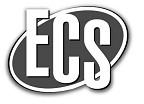 Journal of The Electrochemical Society, 161(5) A718-A725 (2014)
Journal of The Electrochemical Society, 161(5) A718-A725 (2014)
0013-4651/2014/161(5)/A718/8/$31.00©The Electrochemical Society
Electrochemical Kinetics of Nanostructured Nb2O5 Electrodes
Jeremy Come,a,b Veronica Augustyn,c Jong Woung Kim,c Patrick Rozier,a,b Pierre-Louis Taberna,a,b Pavel Gogotsi,d,e Jeffrey W. Long,d,∗ Bruce Dunn,c,∗and Patrice Simona,b,∗,z
a Universit´ e Paul Sabatier, CIRIMAT UMR CNRS 5085, 31062 Toulouse Cedex 4, France
b R´ eseau sur le Stockage Electrochimique de l’Energie (RS2E), FR CNRS 3459, France
c Department of Materials Science & Engineering, University of California, Los Angeles, California 90095, USA
d Surface Chemistry Branch, Naval Research Laboratory, Washington, DC 20375, USA
Псевдоемкостное накопление заряда происходит на основе реакций фарадеевского переноса заряда, протекающих на поверхности или вблизи поверхности редокс-активных материалов. Это свойство представляет большой интерес для создания электрохимических конденсаторов большой емкости - намного более высокой, чем получаемой, например, для сравнения, с помощью процессов в традиционных электродах с электрическим двойным слоем.
Не смотря на то, что были получены высокие уровни псевдоемкости для наноматериалов, практическое развитие реальных электродных структур, которые обладают псевдоемкостнеыми свойствами, остается сложной задачей.
В настоящей работе ученые демонстрируют, что электроды из Nb2O5 могут успешно сохранять псевдоемкостные свойства соответствующих наноразмерных материалов. Показано что, для короткого времени зарядки менее одной минуты, нет никаких признаков полубесконечных диффузионных ограничений, и были получены конкретные емкости из 380 Fg -1 и 0.46 Fsm -2 в электродах толщиной 40 мкм при среднем потенциале разрядки 1,5 В применительно к Li+/ Li. Естественное состояние дифракции рентгеновских лучей показывает, что высокая удельная емкость и мощность электродов из Nb2O5 может объясняться быстрой интеркаляцией ионов лития Li+ в рамках конкретных плоскостей в орторомбической структуре.
Этот механизм интеркаляционной псевдоёмкостной зарядки-разрядки характеризуется как собственное внутреннее свойство Nb2O5, что упрощает конструкцию электродов для устройств емкостного накопителя. Авторы демонстрируют эффективность этих электродов в гибридной электрохимической ячейке, плотность энергии и удельная мощность которых превзошла коммерческие устройства на углеродной основе.
© 2014 The Electrochemical Society. [DOI:10.1149/2.040405jes]
Подробнее о псевдоёмкостном механизме накопления энергии